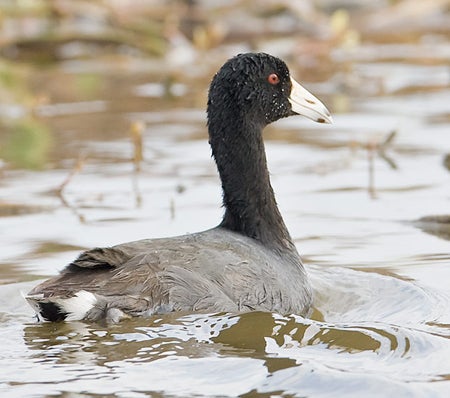SCIENTIFIC NAME:
Fulica americana
OTHER NAMES:
mud hen, water hen, marsh hen, moor-head, water chicken, pull-doo, “poule d’eau.”
STATUS:
Occasional breeder. Common in winter, common to uncommon in spring and fall, and rare in summer in all regions. Low Conservation Concern.
DESCRIPTION:
American coots are dark duck-like birds 12-16 inches in length with a wing span of 20-25 inches and weighing one to two pounds. Their body is predominately dark slate in color with some olive hues. The head and neck tend to be more blackish and their short tail has white under coverts. The tips of the secondary wing feathers are white. The bill is white with a dark ring near the end and is triangular shaped like a chicken’s beak. There is a fleshy frontal shield that is tan in color with a red spot visible at close range at the base of the upper bill. Its eyes are red. The olive green feet are large with long toes. The toes have lobed flaps on the sides. The sexes are similar in appearance. Immature coots are similar to adults but paler and lack the frontal shield and the ring on the bill of the mature coot.
DISTRIBUTION:
Fulica americana is the only coot species to inhabit the United States. It is widely distributed and abundant in Canada, the contiguous 48 states, Mexico, and into Central America.
HABITAT:
The American coot prefers bodies of freshwater with emergent vegetation. It is often seen in lakes, reservoirs, ponds, marshes, swamps, wetlands or on grass banks near bodies of water. It also utilizes estuaries and salt water.
FEEDING HABITS:
The coot is sometimes mistaken for a duck since its feeding habits and habitats they are found in are similar. It is omnivorous, and can be seen dabbling for seeds, algae, aquatic insects, and small fish on open water. It can also dive and feed on roots, snails, and worms. It is adapted to walking on land where it browses green vegetation, eats worms and insects.
LIFE HISTORY AND ECOLOGY:
Coots are migratory birds spending the spring and summer months in the northern United States and Canada. Cooler temperatures in the fall stimulate them to migrate to the southern states and into the tropics. A small percentage of coots remain in the southern states as year-round residents.
Coots begin courtship and breeding as early as April and finish in July. They are very social birds and many pairs will nest in the same general area. The nest is constructed on the water’s surfaceanchored in emergent live weeds or on a floating platform. It consists of a pile of dead vegetation with a depression to hold the eggs. The hen will lay 6 to 16 tan colored eggs covered with dark specks. Incubation begins when the first egg is laid and continues for 20 to 25 days per egg. Only one clutch of eggs is laid annually. Both the male and female share in incubation and brooding of the young. As the young depart the nest, one parent will continue incubation and the other will lead the young. Newly hatched coots are covered with dark colored down with orange or red hair like feathers on the head and neck.
Summers are spent foraging for food by dabbling in water or browsing near shorelines. The coot is very agile while on land. It is often seen along banks and is easily identified. It has a peculiar walk, bobbing its head, as it twitches and cocks its tail, which exposes the white patches of tail coverts. This jerking of the head is the result of the coot’s monocular vision where each eye can focus on different objects. By moving the head the coot compensates for the lack of depth perception that is normally achieved with binocular vision. When spooked, coots prefer not to fly, but run to the nearest cover or water. If the coot is disturbed while on the water, it will run across the surface and only take flight as a last resort. The coot has a low wing surface to body weight ratio and is not capable of springing directly into the air to take flight. Instead, it must run along the surface until sufficient momentum is gained to take flight.
Though the coot is often seen dabbling on the water surface, it is also an accomplished diver using its large lobed feet to propel it underwater by pushing its feet alternately back and forth.
Coots become completely flightless for about a month when molting to replace their flight feathers. During this time period, they must escape their enemies by running, swimming, diving, or hiding. They are very secretive during this time period.
Cold weather in northern states causes them to migrate south for the winter. They typically begin arriving in Alabama during October. The coot is a legal game bird in many states including Alabama. It is hunted during the same seasons as ducks. Not many hunters harvest coots even though they are the most numerous waterfowl species available during the hunting season. They can be seen in large groups in Alabama during the winter. Coots have a life span of about nine years.
REFERENCES:
Cornell Lab of Ornithology All About Birds. American Coot
Cruickshank, Allan D. and Helen G. Cruickshank, 1976. 1001 Questions Answered about Birds, Dover Publications, Inc. Pages 27, 29-31, 87-88, 120, 125, and 129.
Pearson, T. Gilbert, Editor, Herbert K. Job, Author, 1936. Birds of America, Doubleday and Company, Garden City, New York. Pages 214-215
https://www.mbr-pwrc.usgs.gov/id/framlst/framlst.shtml
AUTHOR:
Steve Bryant, Wildlife Biologist, Division of Wildlife and Freshwater Fisheries






